Abstract
This study analyzed the biomechanical behavior under simulated conditions between a novel modification of the Low Z plasty (NM-Low Z) technique and the conventional Hunsuck–Epker (HE) technique on mandibular advancement surgery. The NM-Low Z technique was developed with the purpose of reducing post-operative complications by facilitating the operative method of lower jaw surgery. The models were investigated under physiological muscular and occlusal loads at 1, 2, 4, 6, and 8 weeks post-operation. Finite element analysis was used to analyze stress distribution, elastic strain, and model displacement. Maximum equivalent von Mises stresses were observed on the fixation system and bone. The elastic strain at the fracture site represented the optimal bone-healing capacity. The NM-Low Z model showed lower stress than the HE model at the 2-week post-operation stage and onwards. The elastic strains observed in both models were situated within the normal range for bone healing. The ranges of displacement for the NM-Low Z model were less than those in the HE model. Based on the data sets studied, the biomechanical study of the NM-Low Z technique can be favorably compared to the conventional HE technique. The NM-Low Z technique promotes post-operation skeletal stability by lowering stress on fixation and bone, with less displacement of the segment during bone-healing periods.
1. Introduction
Bilateral sagittal split osteotomy (BSSO) is the most often utilized surgical technique for treating mandibular abnormalities. It is a highly stable and predictable surgical orthodontic procedure for mandibular advancement [1]. Since Trauner and Obwegeser introduced the surgical method in 1957, the buccal horizontal osteotomy has developed into a vertical osteotomy by being positioned slightly toward the mandibular angle. Thus, this method needs to be improved to increase the area of bone contact [2,3]. Other writers have updated the surgical procedure. Dal Pont increased the region of bone contact with the buccal cortex by creating a true vertical cut between the first and second molar [3]. Hunsuck changed the procedure in 1968 and recommended making a shorter horizontal medial cut slightly past the lingual to reduce the amount of soft tissue dissection, but his buccal vertical cut was same as Dal Pont’s [4]. Based on Hunsuck’s modification, Epker’s is even more delicate, using a medial–horizontal osteotomy to preserve the neurovascular bundle. He ended this cut just posterior to the lingula [2]. Since then, reports of BSSO modifications have focused on the attempts to reduce intra or post-operative complications such as neurosensory disturbance, unfavorable splits, relapse, condylar resorption, and post-operative infection [5,6]. Recently in Thailand, a BSSO modification was reported as the Novel Modification of Low Z plasty (NM-Low Z plasty) in 2021 [7]. Compared to the Hunsuck and Epker modification, this technique provides many advantages [7,8]. The osteotomy line starts at the most superior point of the retromolar triangle called the horizontal cut, then extends approximately 6–7 mm posteroinferiorly toward the buccal shelf of the mandible. Continuing from the tip of the triangle to the lateral external oblique ridge, the sagittal cut is made. After that, at the buccal alveolar bone between the first and second mandibular molars, the vertical cut is created [7]. The purpose of this modification is to avoid identification of the lingula; therefore, temporalis tendon muscular detachment is not required. This leads to the shortening of the operative period and less post-operative swelling [7]. After mandibular positional setting, the proximal and distal segments are regularly stabilized by internal fixation using miniplates and screws [9].
Clinical features demonstrate the improved quality of life following surgery [10,11]. The study on the quality of life in patients who underwent surgery through the NM-Low Z technique in Thammasat University Hospital showed improvements in facial esthetics and awareness of facial deformities 1 month after the surgery [11]. Otherwise, one of the most commonly reported undesirable side effects of the mandibular advancement procedure was skeletal instability. This means that the mandible was unable to be retained in the post-operative position, resulting in relapse after surgery, whether in a horizontal or vertical direction [12].
An increased propensity to relapse is linked to an advancement of more than 7 mm [13]. The range for the percentage of horizontal skeletal relapse was 6 to 30% [12,13,14]. Many factors influence skeletal stability, such as intraoperative change in the mandibular plane angle [14], the magnitude of advancement [12,13,15], and skeletal muscle detachment [16]. According to the previous systematic review, the group in which the medial pterygoid muscle and the stylomandibular ligament were stripped exhibited reduced skeletal relapse [16]. Although the suprahyoid muscles had an impact on skeletal relapse, if these muscles were stretched to less than 30% of their resting length, they did not substantially contribute to relapse [17,18]. A condylar-ascending ramus position was another factor. Following the surgical displacement of the mandibular condyles from their functional site in the glenoid fossae, a noticeable skeletal relapse occurred after intermaxillary fixation was withdrawn [17]. Higher frequency and greater severity of horizontal relapse were linked to high-angle patients, with an average mandibular plane angle of 43.0° ± 4.0°. Relapse in the high-angle group occurred more gradually, whereas nearly 95% of the horizontal post-operative alterations in the low-angle group occurred within the first two months [19]. To determine the post-surgical condition, biomechanical behavior should be evaluated [9]. Instead of in vitro measurements of mandibular specimens, finite element analysis (FEA) was the engineering method that was used to solve dental complex situations in [20]. The accuracy of FEA for describing biomechanical behavior has been reported in many publications [20,21]. These have discovered a strong relationship between experimental research and FEA simulation [9,22]. The previous studies of biomechanical behavior and BSSO included comparisons of the BSSO technique, type of fixation, and location of fixation system [9,22,23]. The existing literature on mandibular advancement surgery primarily focuses on factors influencing skeletal relapse [1,14,24], but there is a lack of research specifically examining biomechanic behavior. Biomechanical results are essential for advancing our understanding of the simulation of the mandibular under loading and for helping surgeons to consider their preferred surgery techniques. Even though FEA studies on orthognathic surgery have been conducted, they did not use the most recent osteotomy approach to examine the mechanical behavior in mandibular advancement [9,23,25].
This study aimed to evaluate the biomechanical characteristics of the NM-Low Z technique compared to Hunsuck/Epker’s technique for the mandibular advancement procedure under various loadings throughout the bone-healing period.
2. Materials and Methods
A mandible was constructed from a CT-derived three-dimensional model under different loading forces at five post-operative stages. The bite force was assigned to the right molar and canine to represent the unilateral clenching task.
2.1. The Inclusion Criteria for CT Data
- -
- Skeletal II mandibular retrognathism that required mandibular advancement surgery;
- -
- Facial symmetry;
- -
- Not previously treated with orthognathic surgery.
2.2. Finite Element Model
The mandibular model was constructed from a computed tomography (CT) scan by a CT scanner (Spectral CT 7500, Philips, Amsterdam, The Netherlands). Digital imaging and communications in medicine (DICOM) files covered the whole skull region (slice thickness 0.6 mm). Data were imported into image processing software (3D slicer, open-source software (https://www.slicer.org/)) to create a 3D geometric model of the mandible. VISI 2017 (Vero software, Cheltenham, UK) program was used to create osteotomy cuts and movement of Hunsuck/Epker (HE) and NM Low-Z models.
2.2.1. Osteotomy Line
- -
- The HE osteotomy line started with a short horizontal lingual cut just superior to the lingula. The buccal vertical cut was distal to the second molar running down to the mandibular notch anterior to the insertion point of the masseteric muscle.
- -
- The NM-Low Z osteotomy started from a horizontal line stretched 6–7 mm posteriorly and inferiorly from the most superior point of the retromolar triangle. The sagittal cut was made from the tip of the triangle, laterally along the external oblique ridge, to the buccal alveolar bone between first and second mandibular molars then down through the inferior border to create a vertical cut [7]. The osteotomy line of both models are shown in Figure 1.
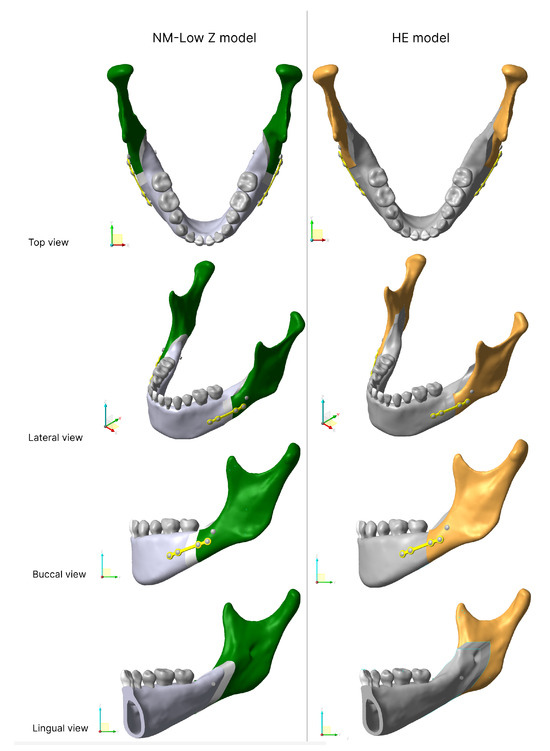 Figure 1. Osteotomy line in NM-Low Z plasty and HE technique from buccal, lingual, top, and lateral view.
Figure 1. Osteotomy line in NM-Low Z plasty and HE technique from buccal, lingual, top, and lateral view.
2.2.2. Advancement and Model Fixation
The distal segments in the two models were moved forward 7 mm parallel to the functional occlusal plane without allowing for a change in the condylar position. The mandibular model was fixed with four-hole straight titanium miniplates, four 2.0 mm monocortical screws, and one bicortical screw (Jeil Medical Corporation, Seoul, Republic of Korea). The fixation system was made from titanium (Ti-6Al-4V) medical grade 5 according to ASTM model. Miniplates were placed along Champy’s lines of ideal osteosynthesis, as close as possible to the alveolar border.
2.2.3. Mesh Generation
Mesh generation of all of the models was performed in the software Patran (MSC Patran, MSC Software Corporation, Newport Beach, CA, USA; https://hexagon.com/products/patran). Four-node tetrahedral elements were used in this study. A convergence test was conducted to obtain the proper number of elements and nodes. Finite element analysis was performed in the Marc-Mentat program (MSC Software, Inc., Newport Beach, CA, USA).
2.3. Material Properties
The material properties for mandible models were assumed to be homogenous transverse isotropic, while teeth, miniplates, and screws were assumed to be homogenous isotropic. Fracture site properties were altered in different stages of bone healing, as inflammatory stage, 2, 4, and 6 weeks post-operation then 8 weeks can be considered cortical and cancellous bone. All material properties are shown in Table 1.

Table 1.
Material properties.
2.4. Boundary Conditions
Each FE model is aligned in a normal axis as a mandibular plane parallel to the ground. In the analysis, constrained displacement occurs at the posterior part of bilateral temporomandibular joints. The loading condition was set as point load for muscular force and unilateral occlusal force on the right side. The amount of loading and magnitudes are displayed in Table 2 and Figure 2.

Table 2.
Muscle and occlusal loading in magnitude and direction.
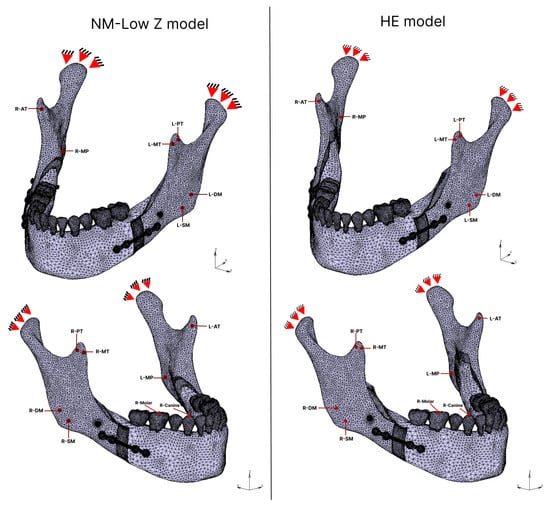
Figure 2.
Point of loading on mandibular models. R = right side, L = left side, AT = anterior temporalis, MT = middle temporalis, PT = posterior temporalis, DM = deep masseter, SM = superficial masseter, and MP = medial pterygoid. Occlusal load on right molar and canine. The red arrow shows the constrained area at posterior part of bilateral temporomandibular joints.
2.4.1. Muscular Force
The muscle force applied to the model was obtained from Huang et al., this studied the effect of clenching tasks on the stress and stability of a mandible and temporomandibular joint (TMJ) condylar prosthesis [30]. The loading conditions were associated with six muscles: the superficial masseter (SM), deep masseter (DM), medial pterygoid (MP), anterior temporalis (AT), middle temporalis (MT), and posterior temporalis (PT). The magnitude and direction of muscle force were applied under right unilateral loading on the medial and lateral surface of the mandible. The same points of loading and magnitude of muscular force were applied to the models in every post-operative stage, in line with the previous study.
2.4.2. Bite Force
The magnitude of occlusal loading was obtained from the study by Gerlach and Schwarz, who measured maximum biting force in mandibular angle fracture patients after treatment by using a force transducer machine [31]. The bite force was applied to models under different loads and in different periods of the bone-healing process. Compressive loads were applied on the right canine and molars perpendicular to the occlusal plane. The magnitudes of bite force in each period are shown in Table 2.
2.5. Contact Condition
Contact conditions were assigned to defined relations between each component. To simplify the analysis in this study, bone bodies and bone–teeth were assigned no relative translation. No relative translation was assigned to a screw that was secured in bone. Since the screw lock-in miniplate was completely tightened, no relative translation was specified as the contact condition. Miniplates and cortical bone were engaged in frictionless relative displacement.
2.6. Element Generation and Convergence Test
The study result was affected by the number of elements, so the mesh convergence test was used to achieve the most advantageous number of elements. The maximum equivalent von Mises stress (EQV) was used to investigate the least possible number of elements. The result of maximum EQV established on the miniplates from the NM Low-Z model and HE model is shown in Figure 3. While the Low Z model graph begins to stabilize at elements from 400,000 to 500,000, the HE model’s graph tends to be more stable in the element range from 300,000 to 400,000. The point at which both models are stable, and overlap was chosen to avoid bias regarding the significant degree of difference elements between the two models. The number of elements and nodes in the NM Low-Z model was 407,716 elements and 102,792 nodes, while the HE model consisted of 411,427 elements and 104,965 nodes, as shown in the convergence graph (Figure 3).
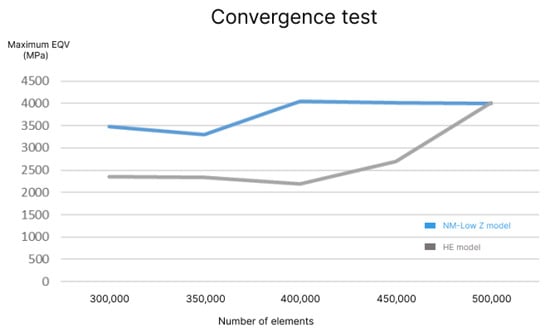
Figure 3.
The graph shows maximum EQV results for convergence test. In total, 407,716 elements (102,792 nodes) and 411,427 elements (104,965 nodes) were selected for NM-Low Z and HE models, respectively.
3. Results
3.1. Fixation Stress
EQV distributed on the miniplates, and screws was intensified in the proximal part of the miniplate and monocortical screws with a higher magnitude on the functional side (right side). There, after the bone was healed, EQV concentrated as a point load on the bicortical screw. The pattern of EQV distribution was similar in both models. The maximal EQV was higher in the NM-Low Z model in the inflammatory stage, and consequently, a lower magnitude of EQV was found in the NM-Low Z model in the other post-operative stages. The lowest magnitude of EQV in the NM-Low Z model was at the 2-week post-operative stage and remained lower than the HE model’s EQV throughout the entire healing process (Table 3 and Figure 4).

Table 3.
Results of maximum EQV in plate and screw, maximum principal value of stress in bone vicinity, and elastic strain.
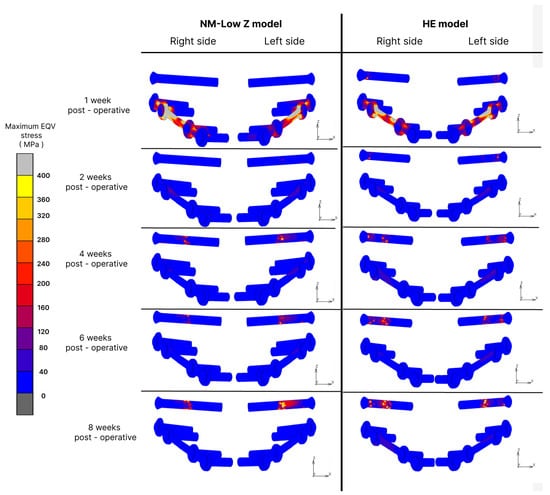
Figure 4.
Maximum EQV distribution on miniplates and screws at 1–8 weeks after surgery.
3.2. Bone Stress
Bone stress was measured on the cortex bone, which consists of proximal and distal segments and bone around the screw hole, known as the bone vicinity. In every stage of bone healing, there was a slight difference between the functional and non-functional sides in these two models. The proportion of the difference ranged between 0.4 and 9%. From the inflammatory stage to 4 weeks post-operation, bone stress showed a tendency to decrease but remained between 6 and 8 weeks. The HE model exhibited higher bone stress than the NM-Low Z model in all post-operative stages (Table 3 and Figure 5).
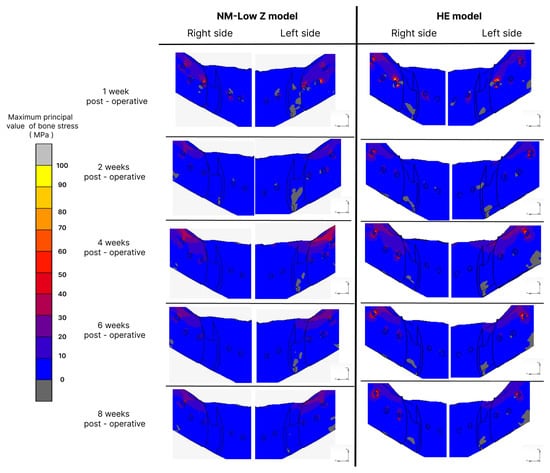
Figure 5.
Maximum principal value of stress on distal and proximal segments.
3.3. Elastic Strain
The elastic strain displayed on fracture sites was high during the inflammatory stage for both models and highest in the NM-Low Z model. The 2–8-week post-operative stages demonstrated lower elastic strain, with a comparable amount of strain in the two models. For the function and non-functional sides, there was no difference in this parameter.
3.4. Displacement
This study measured two types of displacement, as reported in Table 4. The first was relative displacement, which revealed the proximal and distal segment diversity. On the other hand, point B relative displacement was the movement of the deepest point on the mandibular cortex bone in the X, Y, and Z direction. Relative displacement was high in the inflammatory stage, then after 2 weeks post-operation, it was lower in the NM-Low Z model than the HE model. The outcome for point B displacement showed that the model moved upward and forward in the average range of 8 weeks post-operation by 0.4−4.5 mm and 0.1–2.8 mm, respectively (Table 4 and Figure 6).

Table 4.
Results of total displacement at point B and relative displacement.
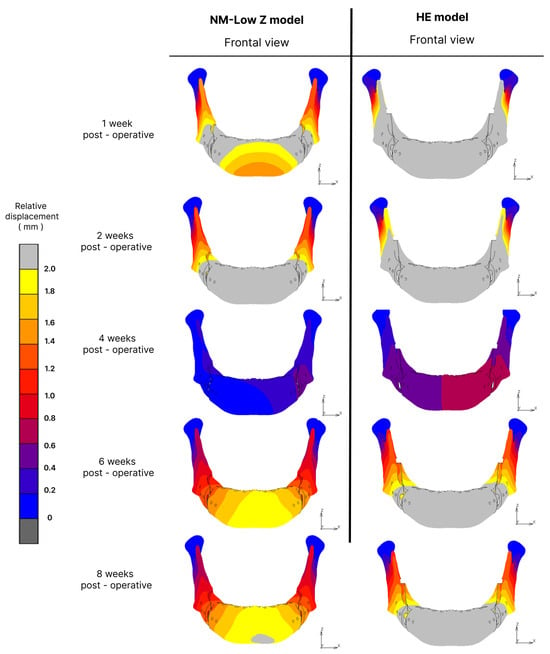
Figure 6.
Total displacement pattern shows that distal segment displaces more than proximal segment in both models.
4. Discussion
This study compares the biomechanical behavior of stimulated mandibular advancement models. The two-osteotomy technique was applied in the FE models which were assigned as transverse isotopic models for constructed teeth, cortical bone, and cancellous bone separately. The material properties in each component of the model were different. These conditions were different from previous FE studies on mandibular advancement [9,23,25,32]. This study’s outcomes were measured after applying the physiological loads of masticatory muscle and bite force. Data was collected at five stages of the post-operative healing period. The minimum number of elements that provided accurate results were obtained by the convergence test.
Convergence testing is essential for ensuring the accuracy and reliability of finite element simulations. It helps to verify that the numerical solution adequately represents the behavior of the system under study and provides confidence in the validity of the results obtained through FEA [33,34]. Most of the models in FEA research must past the convergence test so the data from the analysis can be deemed reliable.
The NM-Low Z model showed a lower maximum EQV on the fixation system in the second-to-eight-week post-operative stage, although this was higher than the HE model in the first week. This can be explained by the fact that the inferior support of the NM-Low Z model helps to support the mandibular segment when the distal segment is moved forward, as shown in Figure 7. Even though the highest maximum EVQ stress in both models exceeded the yield point of the titanium material, it was the point load at which it could not create the fracture in the fixation system. The clinical implications of failure of the fixation system can be shown as malocclusion occurring after surgery [35].
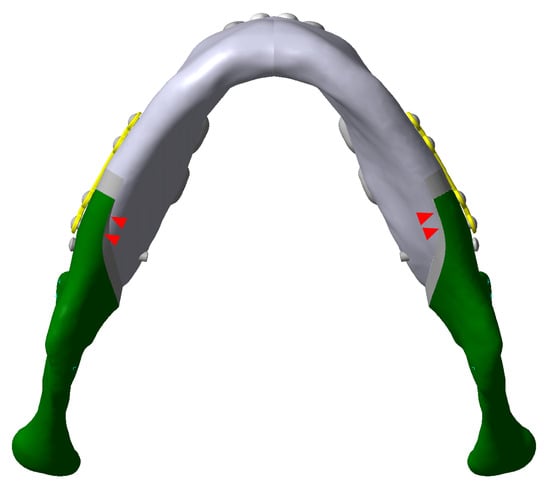
Figure 7.
The inferior support of NM-Low Z model (red arrows).
Both the NM-Low Z and HE models had the same stress distribution patterns, with high stress concentrating on the miniplate attached over the fracture site close to the proximal segment. This was corroborated by Erkmen et al. [22], who discovered that the maximum stress accumulated at the miniplate’s center, close to the fracture location. Also, Puricelli et al. [23], found the maximum stress field to be located on the region of rigid fixation for Puricelli osteotomy and the Obwegeser–Dal Pont technique. Moreover, Takahashi et al. [9], found the greatest concentration of mechanical stress to be on the areas of the screw site and upper border of the miniplate closest to the fracture site. Higher-magnitude muscular loading was delivered to the proximal segment based on the position of the anterior temporalis, medial pterygoid, and superficial masseter muscles, causing a shift in the pattern of stress distribution during the healing phase. Two weeks following surgery, a point load of stress was observed on the bicortical screw; thereafter, additional areas of stress were exhibited.
Bone stress indicated the risk of a secondary fracture in the mandible. Bone stress over the yield point can lead to bone resorption and the loosening of screws [36]. Thus, the clinical outcome after surgery will show a high relapse rate and the displacements of screws in a radiograph [37]. Both models exhibited bone stress that did not exceed the yield point, yet the NM-Low Z model presented a lower maximum bone stress than the HE model. It can be mentioned that this osteotomy technique has a lower risk of secondary bone fracture.
Evaluation of fracture site stability can be indicated by the equivalent elastic strain. Appropriate micro strains have advantages for the bone-healing process [38]. The range of 200–2000 micro strains may contain the naturally permitted initial requirements of bone healing according to Frost Wolff’s law. A favorable strain environment supports osteogenic activity and good bone modeling. The clinical presence of this parameter falls under the reference range shown as nonunion or incomplete bone healing of the mandible, which can be seen as persisting gaps in the radiograph [38]. The elastic strain in the NM-Low Z model was in the range of 1200–1800 micro strains, while in the HE model, it was 900–1300 micro strains. Because of the advancement procedure’s reduced bone contact and the fracture site’s inflammatory stage characteristics, these ranges were high but within the acceptable range for bone healing according to the previous study. The tendency of strain was prone to decrease at 2 weeks after surgery due to the callus formation turning into hard bone.
Relative displacement is the term used to describe the different movement distances between the distal and proximal segments. In every post-operative stage, the NM-Low Z method had a lower value of this parameter than the HE technique. The highest percentage for each technique was at 2 weeks post-operation. The displacement at point B was in the upward and forward direction. In every stage of the post-operative process, the NM-Low Z approach had a lower average movement than the HE approach. Both models moved in the first two weeks after operation because the fracture site was in the soft callus stage and a high magnitude of occlusal force was applied. In addition, this study shows minimum movement in the transverse direction compared to a previous study which reported an average transverse movement about 4 mm in the early post-operative phase. The maximum transverse displacement distribution in the proximal segment was around the gonial region, and the bicortical screw was not used to antirotating in the model [39]. Therefore, it was advised to use one bicortical screw and one miniplate on either side of the fixation. A summary of the results compared with other materials obtained from the literature is shown in Table 5.

Table 5.
Summary of research results compared to reference parameters and previous studies.
Several BSSO modifications have been reported. Dal Pont designed his horizontal osteotomy line to end behind the lingula. The advantage of this technique was that it can increase bone-to-bone contact, but the incision on the mucosa must be extended, and the temporalis tendons had to be detached. This technique was quite similar to the Hunsuck and Epker modifications [42]. When the horizontal osteotomy line was just a few millimeters above the lingula, it was considered a high position. Such a high position of the horizontal osteotomy line could lead to an unfavorable split at the mandibular condyle [43,44]. Another BSSO modification in Thailand was Prasan’s modification, which created the horizontal osteotomy line at a retromolar area. This mandibular osteotomy modification was aimed to prevent such an unfavorable split. The limitation of this technique was an angle between a horizontal and sagittal osteotomy line that could create a bony interference, especially in a mandibular set-back procedure [45]. So, the NM-Low Z plasty technique was developed to modify the BSSO osteotomy line to be in a low position to avoid an undesirable split and causes less tissue detachment but still have acceptable biomechanical support, as presented in this study.
It was discovered that the NM-Low Z approach provided inferior support for the proximal and distal segments, despite the mandibular advancement procedure appearing to have less bone contact. Most of the biomechanical characteristics of the NM-Low Z plasty were comparable to the HE approach. Less EQV on the fixation system and bone were discovered with a higher elastic strain in the inflammatory stage. In clinical situations, the NM-Low Z approach did not differ from the HE approach for bone healing following surgery. The minimal tissue invasion caused by this method also reduced interoperative and post-operative swelling. This can enhance patient satisfaction beyond changing their facial appearance after surgery. Further studies on clinical outcomes, patient satisfaction, and cost effectiveness in the NM-Low Z approach are still in process.
The limitation of this study is that only one mandibular sample was investigated, and in the mandibular model, there was no periodontal ligament nor simulation of the inferior alveolar nerve. The model’s transverse isotropic properties were rather close to those of real bone, although not the same. These factors can affect the outcomes of the study. Moreover, occlusal loading direction and muscle clenching tasks have been assigned in one condition. The muscle force utilized in this study was obtained through a review of the literature rather than being obtained from a clinical examination of patients with skeletal II deformities.
5. Conclusions
This finite element analysis evaluated the biomechanical properties of two different surgical technique simulated models. The NM-Low Z model showed a lower value of stress distribution on the fixation system and bone. Moreover, this model distributed less displacement distance of the segment during bone-healing periods. The NM-Low Z approach can be another choice of the BSSO surgical technique to treat skeletal deformities compare to conventional procedures.
Author Contributions
Conceptualization, S.B., S.I. and N.C.; methodology S.I.; software, S.B. and N.C.; investigation, S.B.; writing—original draft preparation, N.C. and S.P.; writing—review and editing, N.C. and S.B.; supervision, S.P. and N.C. All authors have read and agreed to the published version of the manuscript.
Funding
This research received no external funding.
Institutional Review Board Statement
This study was evaluated and approved by the Ethical Review Sub-Committee Board for Human Research Involving Sciences No. 3 at Thammasat University in Thailand in accordance with the Declaration of Helsinki, the Belmont report, CIMOS guidelines, and international practice (ICH-GCP), project No. 023/2565 (22 February 2022).
Informed Consent Statement
Not applicable.
Data Availability Statement
The data that support the findings of this study are available from the corresponding author upon reasonable request.
Acknowledgments
This study was supported by the Thammasat University Research Unit in Mineralized Tissue Reconstruction, Faculty of Dentistry, Thammasat University, Pathum Thani, Thailand. The technical facilities and assistance were provided by the Digital Industrial Design and Manufacturing Research Unit (DIDM), Kasetsart University, Sriracha campus.
Conflicts of Interest
There are no conflicts of interest regarding this publication according to the authors. No specific grant was given to this study by any funding organization in the public, private, or nonprofit sectors.
References
- Schwartz, K.; Rodrigo-Domingo, M.; Jensen, T. Skeletal Stability after Large Mandibular Advancement (>10 mm) with Bilateral Sagittal Split Osteotomy and Skeletal Elastic Intermaxillary Fixation. J. Oral Maxillofac. Res. 2016, 7, e5. [Google Scholar] [CrossRef]
- Böckmann, R.A. Modification of the Mandibular Split Based on a Physical Model: Experimental Animal and Clinical Studies. Ph.D. Thesis, Maastricht University, Maastricht, The Netherlands, 2017. [Google Scholar]
- Obwegeser, H.L. Orthognathic surgery and a tale of how three procedures came to be: A letter to the next generations of surgeons. Clin. Plast. Surg. 2007, 34, 331–355. [Google Scholar] [CrossRef]
- Monson, L.A. Bilateral sagittal split osteotomy. Semin. Plast. Surg. 2013, 27, 145–148. [Google Scholar] [CrossRef]
- Böckmann, R.; Meyns, J.; Dik, E.; Kessler, P. The modifications of the sagittal ramus split osteotomy: A literature review. Plast. Reconstr. Surg. Glob. Open 2014, 2, e271. [Google Scholar] [CrossRef]
- Verweij, J.P.; Houppermans, P.N.; Gooris, P.; Mensink, G.; van Merkesteyn, J.P. Risk factors for common complications associated with bilateral sagittal split osteotomy: A literature review and meta-analysis. J. Craniomaxillofac. Surg. 2016, 44, 1170–1180. [Google Scholar] [CrossRef]
- Chaiprakit, N.; Oupadissakoon, C.; Klaisiri, A.; Patchanee, S. A Surgeon-Friendly BSSO by the Novel Modification of Low Z Plasty: Approach Focus and Case Report: A Case Report. J. Int. Dent. Med. Res. 2021, 14, 768–772. [Google Scholar]
- Dumrongwanich, O.; Chantarapanich, N.; Patchanee, S.; Inglam, S.; Chaiprakit, N. Finite element analysis between Hunsuck/Epker and novel modification of Low Z plasty technique of mandibular sagittal split osteotomy. Proc. Inst. Mech. Eng. H 2022, 236, 646–655. [Google Scholar] [CrossRef] [PubMed]
- Takahashi, H.; Moriyama, S.; Furuta, H.; Matsunaga, H.; Sakamoto, Y.; Kikuta, T. Three lateral osteotomy designs for bilateral sagittal split osteotomy: Biomechanical evaluation with three-dimensional finite element analysis. Head Face Med. 2010, 6, 4. [Google Scholar] [CrossRef] [PubMed]
- Saghafi, H.; Benington, P.; Ayoub, A. Impact of orthognathic surgery on quality of life: A comparison between orthodontics-first and surgery-first approaches. Br. J. Oral Maxillofac. Surg. 2020, 58, 341–347. [Google Scholar] [CrossRef] [PubMed]
- Thitiyuk, C.; Patchanee, S.; Klaisiri, A.; Chaiprakit, N. Comparison of Orthodontic First and Surgery First Approaches to Quality of Life in Orthognathic Surgery Patients: A Prospective Cohort Study. Appl. Sci. 2022, 12, 12137. [Google Scholar] [CrossRef]
- Tabrizi, R.; Nili, M.; Aliabadi, E.; Pourdanesh, F. Skeletal stability following mandibular advancement: Is it influenced by the magnitude of advancement or changes of the mandibular plane angle? J. Korean Assoc. Oral Maxillofac. Surg. 2017, 43, 152–159. [Google Scholar] [CrossRef]
- Eggensperger, N.; Smolka, W.; Rahal, A.; Iizuka, T. Skeletal relapse after mandibular advancement and setback in single-jaw surgery. J. Oral Maxillofac. Surg. 2004, 62, 1486–1496. [Google Scholar] [CrossRef]
- Sahoo, N.K.; Agarwal, S.S.; Datana, S.; Bhandari, S.K. Long-Term Study of Relapse After Mandibular Orthognathic Surgery: Advancement Versus Setback. J. Maxillofac. Oral Surg. 2022, 21, 469–480. [Google Scholar] [CrossRef] [PubMed]
- Chen, Y.; Zhang, J.; Rao, N.; Han, Y.; Ferraro, N.; August, M. Independent risk factors for long-term skeletal relapse after mandibular advancement with bilateral sagittal split osteotomy. Int. J. Oral Maxillofac. Surg. 2020, 49, 779–786. [Google Scholar] [CrossRef] [PubMed]
- Van den Bempt, M.; Vinayahalingam, S.; Han, M.D.; Bergé, S.J.; Xi, T. The role of muscular traction in the occurrence of skeletal relapse after advancement bilateral sagittal split osteotomy (BSSO): A systematic review. Orthod. Craniofac. Res. 2022, 25, 1–13. [Google Scholar] [CrossRef] [PubMed]
- Epker, B.N.; Wessberg, G.A. Mechanisms of early skeletal release following surgical advancement of the mandible. Br. J. Oral Surg. 1982, 20, 175–182. [Google Scholar] [CrossRef] [PubMed]
- Wessberg, G.A.; Schendel, S.A.; Epker, B.N. The role of suprahyoid myotomy in surgical advancement of the mandible via sagittal split ramus osteotomies. J. Oral Maxillofac. Surg. 1982, 40, 273–277. [Google Scholar] [CrossRef] [PubMed]
- Mobarak, K.A.; Espeland, L.; Krogstad, O.; Lyberg, T. Mandibular advancement surgery in high-angle and low-angle class II patients: Different long-term skeletal responses. Am. J. Orthod. Dentofac. Orthop. 2001, 119, 368–381. [Google Scholar] [CrossRef]
- Shrivastava, N.; Thukral, R.; Garg, A.; Tripathi, A.; Marothiya, S. Stress Pattern and Deformation in Mid-palatal Suture and Posterior Dentoalveolar Area With Two Different Types of Rapid Maxillary Expansion Appliances: A Finite Element Method Study. J. Indian Orthod. Soc. 2021, 55, 278–284. [Google Scholar] [CrossRef]
- Duangrattanaprathip, N.; Rungsiyakull, P.; Rungsiyakull, C.; Suttiat, K. Basic Knowledges of Finite Element Method and Application in Implant Dentistry. Chiang Mai Dent. J. 2018, 39, 29–42. [Google Scholar]
- Erkmen, E.; Simsek, B.; Yucel, E.; Kurt, A. Three-dimensional finite element analysis used to compare methods of fixation after sagittal split ramus osteotomy: Setback surgery-posterior loading. Br. J. Oral Maxillofac. Surg. 2005, 43, 97–104. [Google Scholar] [CrossRef]
- Puricelli, E.; Fonseca, J.S.; de Paris, M.F.; Sant’Anna, H. Applied mechanics of the Puricelli osteotomy: A linear elastic analysis with the finite element method. Head Face Med. 2007, 3, 38. [Google Scholar] [CrossRef]
- Rao, S.H.; Selvaraj, L.; Lankupalli, A.S. Skeletal stability after bilateral sagittal split advancement and setback osteotomy of the mandible with miniplate fixation. Craniomaxillofac. Trauma Reconstr. 2014, 7, 9–16. [Google Scholar] [CrossRef]
- Stringhini, D.J.; Sommerfeld, R.; Uetanabaro, L.C.; Leonardi, D.P.; Araujo, M.R.; Rebellato, N.L.; Costa, D.J.; Scariot, R. Resistance and Stress Finite Element Analysis of Different Types of Fixation for Mandibular Orthognathic Surgery. Braz. Dent. J. 2016, 27, 284–291. [Google Scholar] [CrossRef]
- O’Mahony, A.M.; Williams, J.L.; Spencer, P. Anisotropic elasticity of cortical and cancellous bone in the posterior mandible increases peri-implant stress and strain under oblique loading. Clin. Oral Implant. Res. 2001, 12, 648–657. [Google Scholar] [CrossRef]
- Thote, A.M.; Patil, R.V. Estimation of the maximum permissible intrusive force for intrusion of a canine tooth: One-dimensional finite element study. Mater. Today Proc. 2022, 51, 918–923. [Google Scholar] [CrossRef]
- Ghiasi, M.S.; Chen, J.E.; Rodriguez, E.K.; Vaziri, A.; Nazarian, A. Computational modeling of human bone fracture healing affected by different conditions of initial healing stage. BMC Musculoskelet. Disord. 2019, 20, 562. [Google Scholar] [CrossRef]
- Isaksson, H.; Wilson, W.; van Donkelaar, C.C.; Huiskes, R.; Ito, K. Comparison of biophysical stimuli for mechano-regulation of tissue differentiation during fracture healing. J. Biomech. 2006, 39, 1507–1516. [Google Scholar] [CrossRef] [PubMed]
- Huang, H.L.; Su, K.C.; Fuh, L.J.; Chen, M.Y.; Wu, J.; Tsai, M.T.; Hsu, J.T. Biomechanical analysis of a temporomandibular joint condylar prosthesis during various clenching tasks. J. Craniomaxillofac. Surg. 2015, 43, 1194–1201. [Google Scholar] [CrossRef] [PubMed]
- Gerlach, K.L.; Schwarz, A. Bite forces in patients after treatment of mandibular angle fractures with miniplate osteosynthesis according to Champy. Int. J. Oral Maxillofac. Surg. 2002, 31, 345–348. [Google Scholar] [CrossRef]
- Ghorashi, S.; Keshavarzi, M.; Damercheli, S.; Parhiz, A. The comparison of three different fixation methods on bilateral sagittal split ramus osteotomy mandibular on a 3D of fully modelled mandible by the finite element method. JCR 2019, 6, 113–121. [Google Scholar]
- Melosh, R.J. Finite element analysis convergence curves. Finite Elem. Anal. Des. 1990, 7, 115–121. [Google Scholar] [CrossRef]
- Ayturk, U.M.; Puttlitz, C.M. Parametric convergence sensitivity and validation of a finite element model of the human lumbar spine. Comput. Methods Biomech. Biomed. Eng. 2011, 14, 695–705. [Google Scholar] [CrossRef] [PubMed]
- Ellis, E., 3rd; Esmail, N. Malocclusions resulting from loss of fixation after sagittal split ramus osteotomies. J. Oral Maxillofac. Surg. 2009, 67, 2528–2533. [Google Scholar] [CrossRef]
- Kundu, J.; Pati, F.; Shim, J.H.; Cho, D.W. 10—Rapid prototyping technology for bone regeneration. In Rapid Prototyping of Biomaterials; Narayan, R., Ed.; Woodhead Publishing: Cambridge, UK, 2014; pp. 254–284. [Google Scholar] [CrossRef]
- Feng, X.; Lin, G.; Fang, C.X.; Lu, W.W.; Chen, B.; Leung, F.K.L. Bone resorption triggered by high radial stress: The mechanism of screw loosening in plate fixation of long bone fractures. J. Orthop. Res. 2019, 37, 1498–1507. [Google Scholar] [CrossRef]
- Frost, H.M. A 2003 update of bone physiology and Wolff’s Law for clinicians. Angle Orthod. 2004, 74, 3–15. [Google Scholar] [PubMed]
- Dai, Z.; Hou, M.; Ma, W.; Song, D.L.; Zhang, C.X.; Zhou, W.Y. Evaluation of the Transverse Displacement of the Proximal Segment After Bilateral Sagittal Split Ramus Osteotomy with Different Lingual Split Patterns and Advancement Amounts Using the Finite Element Method. J. Oral Maxillofac. Surg. 2016, 74, 2286.E1–2286.E11. [Google Scholar] [CrossRef]
- Haden, C.V.; Collins, P.C.; Harlow, D.G. Yield Strength Prediction of Titanium Alloys. JOM 2015, 67, 1357–1361. [Google Scholar] [CrossRef]
- Bianchi, A.E.; Dolci, G., Jr.; Sberna, M.T.; Sanfilippo, S. Factors affecting bone response around loaded titanium dental implants: A literature review. J. Appl. Biomater. Biomech. 2005, 3, 135–140. [Google Scholar]
- Steenen, S.A.; van Wijk, A.J.; Becking, A.G. Bad splits in bilateral sagittal split osteotomy: Systematic review and meta-analysis of reported risk factors. Int. J. Oral Maxillofac. Surg. 2016, 45, 971–979. [Google Scholar] [CrossRef] [PubMed]
- Posnick, J.C.; Choi, E.; Liu, S. Occurrence of a ‘bad’ split and success of initial mandibular healing: A review of 524 sagittal ramus osteotomies in 262 patients. Int. J. Oral Maxillofac. Surg. 2016, 45, 1187–1194. [Google Scholar] [CrossRef]
- Posnick, J.C.; Kinard, B.E. Use of a ‘low and short’ medial cut limits sagittal ramus osteotomy interferences. Int. J. Oral Maxillofac. Surg. 2021, 50, 1583–1587. [Google Scholar] [CrossRef]
- Tangarturonrasme, P.; Laddawun, S. Modified bilateral sagittal split osteotomy for correction of severe anterior open bite: Technical note and case report. Chula Med. J. 2016, 60, 45–54. [Google Scholar]
Disclaimer/Publisher’s Note: The statements, opinions and data contained in all publications are solely those of the individual author(s) and contributor(s) and not of MDPI and/or the editor(s). MDPI and/or the editor(s) disclaim responsibility for any injury to people or property resulting from any ideas, methods, instructions or products referred to in the content. |
© 2024 by the authors. Licensee MDPI, Basel, Switzerland. This article is an open access article distributed under the terms and conditions of the Creative Commons Attribution (CC BY) license (https://creativecommons.org/licenses/by/4.0/).